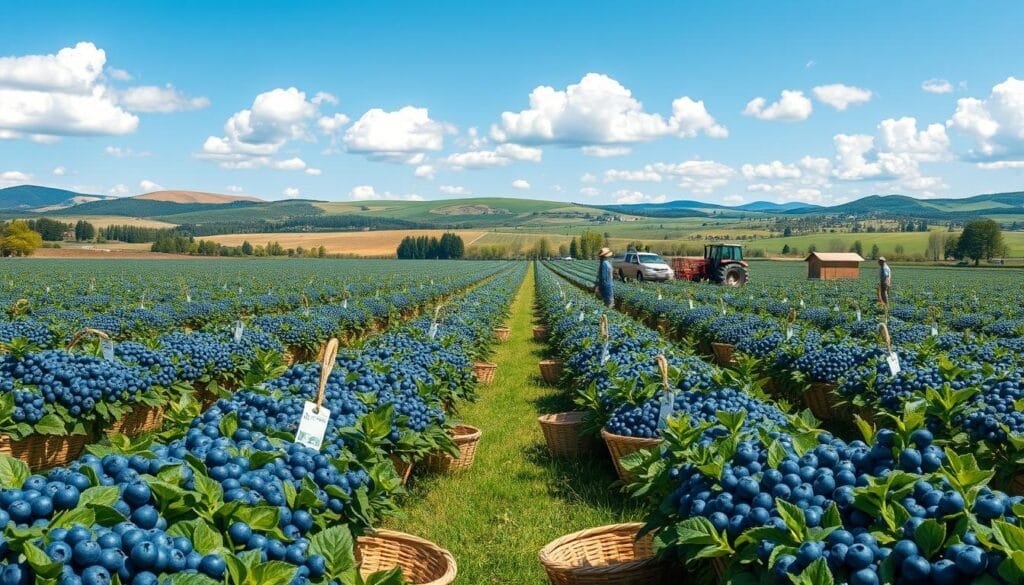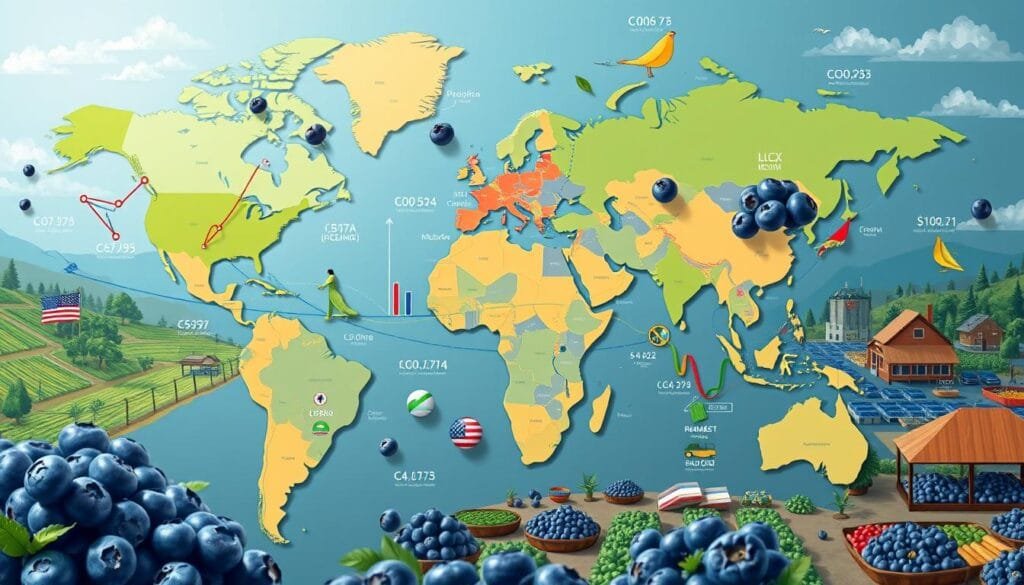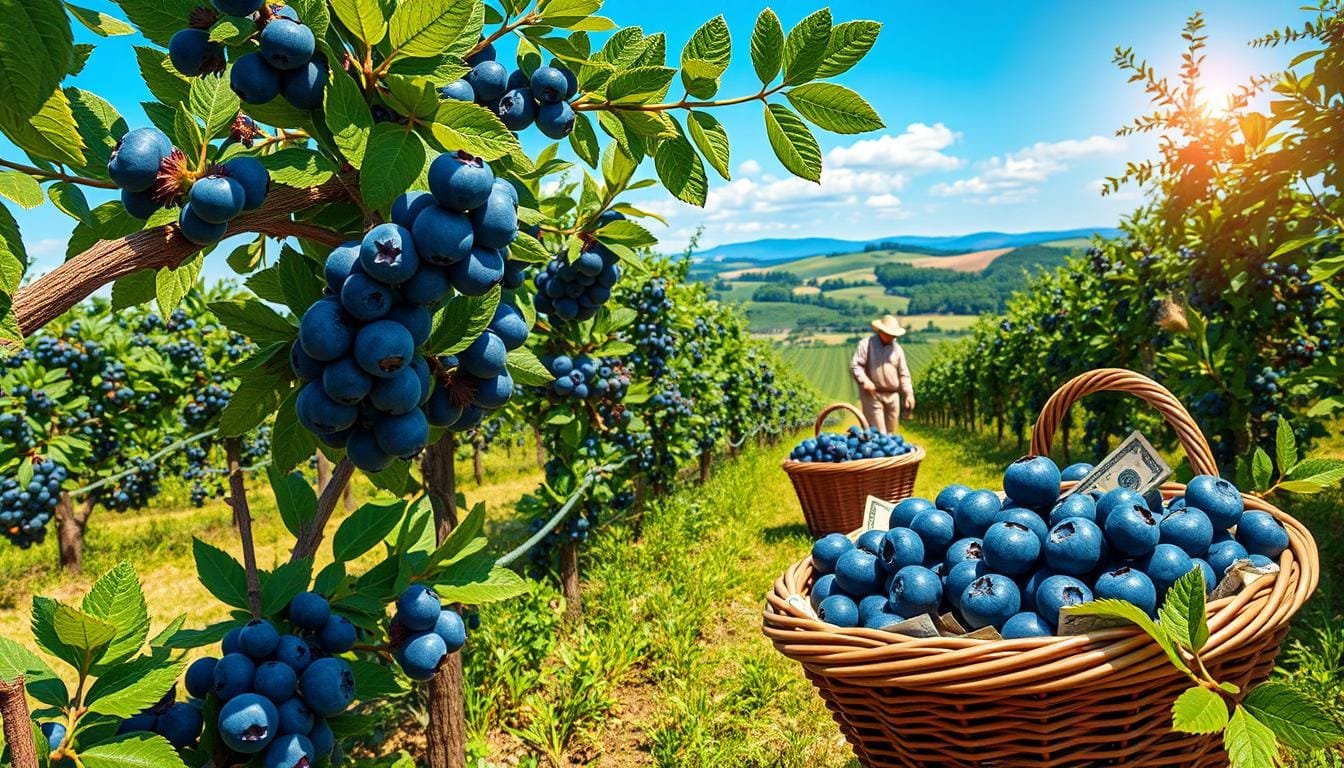Blueberries play a big role in agriculture’s economy. They have become a key part of America’s farming scene. Their economic effects are felt in many areas, creating jobs and boosting local economies. According to Dennis Tootelian of the U.S. Highbush Blueberry Council, blueberries offer more than just health benefits. They bring in $4.7 billion a year and create 44,500 jobs. They also provide $145 million in business taxes annually. This shows their strong economic impact.
The cost to grow blueberries varies by state. This is due to different growing conditions, like Oregon’s acidic soils or Florida’s sunny fields. States like California, Georgia, and Michigan are top growers. Blueberries have become a key export for these states. This helps agricultural economics to flourish.
Key Takeaways
- Blueberries provide a remarkable $4.7 billion in economic activity in the U.S. annually.
- The fruit’s market demand is bolstered by its acclaimed health benefits and cultural significance.
- Blueberries have a storied tradition, with Native Americans utilizing these berries long before they became an agricultural commodity.
- Technological advancements and soil condition research have greatly improved blueberry yields over the years.
- From 1995 to 2017, blueberries saw a 500% increase in harvested acres in the fertile Willamette Valley.
- The blueberry industry’s growth reflects not only an increase in consumption but also innovation in farming practices.
- Understanding the economics of blueberry production can aid in strategic decision-making for current and prospective growers.
Blueberries in the United States: A Billion Dollar Industry
Looking into the U.S. blueberry production, we see more than farming. It’s a big economic force. Economic activity of blueberries creates jobs and investments. It shows how farming can boost local economies and support sustainable growth.
Annual Economic Activity Generated by Blueberries
Blueberries add about $4.7 billion a year to the U.S. economy. This includes everything from the farms to the stores. It means over $12.7 million is made daily from blueberries, showing their economic strength.
Employment Opportunities Stemming from Blueberry Production
Blueberry farming and sales create about 44,535 jobs annually. These jobs help local economies and provide stable income for many families. It involves various steps from growing to selling blueberries.
Variation in Production Costs Across States
Growing blueberries costs differently in each state. This is due to the climate, soil, labor, and tech used. For instance, North Carolina and New Jersey have costs around $7,500 and $7,900 per acre. But in California, costs shoot up to $31,600 per acre due to high labor and land costs. Knowing these differences helps farmers plan better.
| State | Cost per Acre |
|---|---|
| North Carolina | $7,500 |
| New Jersey | $7,900 |
| California | $31,600 |
What is the economic importance of blueberries
Blueberries play a big role in both local and national economies. They help local economies grow and add to the country’s tax money. To see their real value, we look at how they boost local areas and their effect on national finances.
Impact on Local and National Economies
Blueberries make a difference in local economies by bringing money to farmers and supporting related businesses. They also help create demand for many services linked to them. Blueberry farming leads to more jobs in retail, transport, and agriculture. At the national level, blueberries add to tax revenues thanks to more business activities and exports. They are key to the economy.

Contribution to Employment and Tax Revenue
Blueberry farms are a big deal for the economy, creating thousands of jobs. In the U.S., they support over 44,535 full-time jobs in agriculture. This brings in almost $1.8 billion in work income every year. More blueberry farming means more money for the country through taxes, showing how important they are for economic plans.
The Role of Blueberries in Export Markets
Blueberries are also important in global trade. The U.S. is a top blueberry exporter, especially to Canada. This helps balance the country’s trade. The strong demand for U.S. blueberries around the world boosts trade ties and the nation’s economic image. Growing exports show how vital blueberries are and display America’s agricultural might worldwide.
| Year | U.S. Blueberry Production (Pounds) | Value (USD) | Export Value (USD) |
|---|---|---|---|
| 2021 | 660 million | $720.2 million | $134.7 million |
| 2020 | Data not specified | Data not specified | $121 million |
| 2019 | Data not specified | Data not specified | 30% increase from 2010 |
Trends in Global Blueberry Production and Trade
The global blueberry market has grown a lot, thanks to more blueberries being grown and more being sent overseas. There’s now a big focus on improving how they’re grown and sent to places all over the world. Because of this, we can enjoy blueberries any time of the year. Let’s look more closely at how this growth happened.
Dramatic Increase in Global Production
Blueberry farms from North America to the Southern Hemisphere have seen a big jump in how much they grow. This big increase in blueberry production is thanks to better farming technology and more people wanting these healthy berries.
The Rising Star: Peru’s Blueberry Export Boom
Peru has become very important in the global blueberry market, giving older producers a run for their money with its big export boom. Almost all of Peru’s blueberries are sold to other countries, making it a top exporter. In the 2022/23 season, the blueberry industry in Peru gave jobs to over 120,000 people.
What’s really great is that 60% of these workers are women. This shows how the blueberry industry is helping everyone.
United States as a Global Leader in Blueberry Production
The United States is very important in the global blueberry market. It grows blueberries all year round because of its many types of weather and new farming methods. This lets the U.S. send lots of blueberries to other places and keep its spot as a key player in berry farming around the world.

Blueberries are getting more popular and valuable all over the world. They used to be just a seasonal treat, but now they’re an important part of global trade. With plans to grow even more and reach new markets, the future looks bright for the global blueberry market.
From Domestication to Global Expansion
The story of how blueberries went from wild bushes to worldwide kitchens is amazing. It shows how smart farming and breeding created a fruit everyone loves. Now, blueberries are big business and a favorite food everywhere.
The Historical Development of Cultivated Blueberries
In the 1900s, Elizabeth White from New Jersey worked with a scientist named Frederick Coville. They turned wild blueberries into ones we can grow on farms. Their success in 1916 started the blueberry farming we know today.
Thanks to their work, places like New Jersey, Oregon, and Michigan became leaders in blueberry farming. They lead the way in producing these tasty berries.
Technological and Genetic Advances Enhancing Production
The need for more blueberries made farmers use new tech. The University of Florida created a type of blueberry in 1950 that could grow in warm places. This meant more blueberries all year round.
Now, farmers use cool tech to grow better blueberries. They also work on making them last longer and fight diseases. This is key for sending blueberries all over the world.

Now, over 30 countries grow blueberries thanks to advanced farming and hard work. These efforts make sure blueberries will be a healthy snack option for everyone, everywhere, far into the future.
The Strategic Importance of Blueberry Trade Policies
The international trade agreements, blueberry trade impact, and trade policies play a key role in the blueberry industry’s economy. Creating strategic trade policies tackles global market challenges. It also promotes sustainable growth in this sector.
Understanding blueberry trade policies is key for balancing local production and imports. Trade data shows how international agreements affect growers and exporters.
| Country | Blueberry Exports to the U.S. (2020) | Change in Exports (2017-2020) |
|---|---|---|
| Peru | 184,212 tons | +342.3% |
| Chile | 115,366 tons | -23.6% |
| Mexico | Close to surpassing Chile | Steady increase |
The statistics emphasize the blueberry trade impact and international trade agreements. Peru’s exports have increased due to better trade conditions and farm innovations. Meanwhile, Chile’s exports to the U.S. are decreasing. Thus, we need strong trade policies to protect our growers and economy.
Trade policies’ strategic value lies in managing imports and exports. They also improve the market through stability and growth. Using tools like the Importance-Performance Analysis (IPA) guides stakeholders. They can focus on key factors such as price, pesticide-free products, and natural growing methods. These significantly sway consumer choices and market demand.
In the global market arena, the future of the blueberry sector depends on smart policies. These need to align with global trends and address local needs for continued growth and stability.
Innovations in Blueberry Consumption and Use
People are now enjoying blueberries in new ways, showing they love both the taste and health perks. There are cool new products made from blueberries, like jams and snacks. This is changing how we use blueberries, beyond just eating them fresh.
Extending the Blueberry Market: From Fresh to Processed Products
There’s been a big jump in using blueberries not just fresh, but also in processed forms. This change is because blueberries are getting more popular and valuable, hitting $8 billion globally in 2021. Now, we have tasty blueberry products like jams and juices that make eating them easier and boost our intake.
Blueberries in Health and Wellness Trends
Blueberries are famous for being healthy. They’re packed with vitamins C and K, fiber, and polyphenols, like anthocyanins. This has made them key in health food products, supplements, and drinks. Because they have a lot of antioxidants, they’re great for wellness-focused products.
New Markets: Blueberry Leaves for Tea
Looking at blueberries differently has shown the value of their leaves. These leaves are now used for making herbal tea. This means we’re using more of the blueberry plant and giving people a new, health-boosting drink to try.
| Product | Usage Increase | Health Benefit Focus |
|---|---|---|
| Blueberry tea | Emerging market | Antioxidant properties |
| Blueberry supplements | +30% annually | High in Vitamins C and K |
| Processed blueberries | +41% by 2027 | Dietary fiber and polyphenols |
Blueberries are becoming more popular in different forms and products worldwide. The health benefits they offer make blueberries a top pick. From processed goods to blueberry leaf tea, the fruit’s value continues to grow.
Conclusion
As we look back at the data and talks, we see the huge impact of blueberries on the economy. They bring in about $449 million in Georgia, showing their importance to local economies. The blueberry season runs from March to July.
This is when we see everything from the start to the ripe fruit. Things like pollination and temperature play a big part. They decide the fruit quality and how much it’s worth.
Looking ahead, the blueberry industry is full of opportunities. Changes in fruit quality need flexible farming methods. Profit analysis helps ensure the industry stays strong for years to come.
Blueberries show us the power of innovation in farming. Farmers deal with temperature changes and shifting markets. They learn cost patterns to make their farms more efficient and profitable.
Blueberries are important for their health benefits and their economic impact. Now is a key time for blueberries. Everything from pollination to pricing affects their overall success. If people manage resources and respond to the market well, blueberries will keep being valuable in agriculture worldwide.
FAQ
What is the economic impact of blueberries on the U.S. economy?
Blueberries add a lot to the U.S. economy. They bring in .7 billion every year. They create 44,500 jobs and lead to 5 million in taxes annually.
What are the top blueberry-producing states in the United States?
The top states for blueberry production include California and Florida. Others are Georgia, Michigan, New Jersey, North Carolina, Oregon, and Washington.
How do blueberries impact local and national economies?
Blueberries help local economies by creating jobs and bringing industry money. They also generate a lot of tax revenue, except for income tax.
Have global blueberry production and trade increased in recent years?
Yes, global blueberry production has doubled from 2010 to 2019. Countries like Peru now grow blueberries all year, boosting exports.
Who were the pioneers of blueberry domestication, and how has their work influenced the industry?
Elizabeth White and USDA botanist Frederick Coville started domesticating blueberries. Thanks to them, blueberries now grow in over 30 countries across different climates.
What role have trade policies played in the blueberry industry?
Trade policies and safeguard investigations help protect U.S. blueberry growers from foreign competition. They’ve been vital for the industry’s stability and growth.
How has the blueberry market expanded beyond fresh fruit?
The blueberry market now includes processed products like yogurts and supplements. There’s even blueberry leaf tea, broadening their market reach.
Why are blueberries increasingly included in health and wellness products?
Blueberries are now more common in health products because they’re healthy. This boosts their demand and makes them popular in consumer goods.
